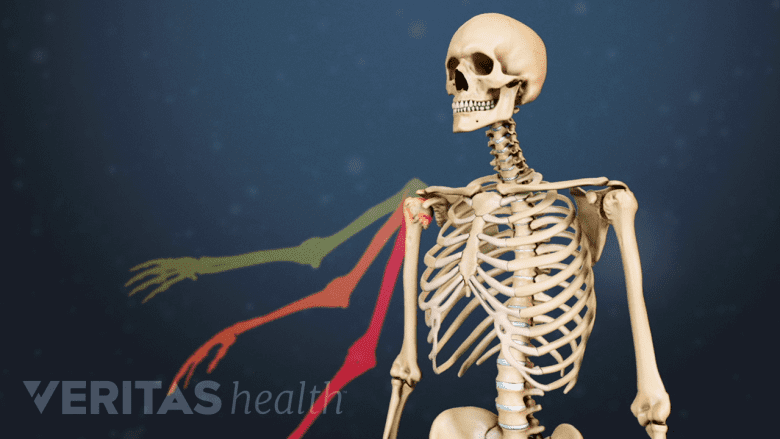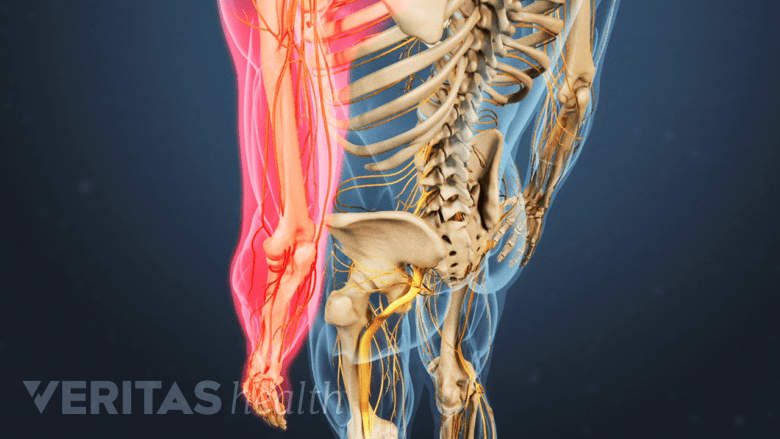Brachial neuritis symptoms can vary depending on which nerves in the brachial plexus are inflamed and damaged, as well as the severity of the damage.
In This Article:
- Brachial Neuritis (Parsonage-Turner Syndrome)
- Brachial Neuritis Symptoms
- Brachial Neuritis Diagnosis
- Brachial Neuritis Treatment
Initial Pain Symptoms

In the acute phase, brachial neuritis pain worsens with arm movements.
The initial symptoms of brachial neuritis typically include pain that is:
- Sudden onset. Brachial neuritis appears without warning. Patients commonly report first experiencing the condition while being awakened by nighttime pain.
- Located in the shoulder and/or upper arm. While most brachial neuritis pain occurs in the shoulder or upper arm, sometimes the pain is also felt in the neck or down in the forearm or hand.
- Severe and unrelenting. In the beginning, brachial neuritis pain tends to be intense and debilitating. The pain may feel sharp, burning, or electric shock-like, and it may shoot down the arm and into the hand. The intense pain may only last a few hours, or it may last weeks or longer.
- Worse with arm movement. Brachial neuritis pain, especially during the acute phase, tends to be exacerbated with arm movements. Other movements, such as neck movements, do not typically worsen brachial neuritis pain.
Brachial neuritis symptoms are almost always felt on only one side of the body. However, there have been cases where it is experienced on both sides (bilateral). There have also been reports of patients with brachial neuritis who only experience symptoms on one side of the body but have had electrodiagnostic studies show abnormal readings on both sides.
Symptoms That Can Develop Later

In brachial neuritis, the affected area may have limited movement, and muscle paralysis can occur.
A few days after brachial neuritis has developed, neurological symptoms may also start to become noticeable, such as:
- Weakness or paralysis. The arm, shoulder, and/or hand might have reduced abilities for movement, and in some cases total paralysis of one or more muscles may be present. Depending on the severity, muscle atrophy (loss of muscle mass due to lack of use) can occur.
- Prickling or tingling. Altered skin sensations may be experienced, such as feelings of being pricked by small needles.
- Numbness. Certain parts of the skin may experience loss of sensation. Numbness can be dangerous as it reduces the ability to avoid skin damage, such as from burns. If numbness is experienced in the hand, it can affect grip and coordination.
- Abnormal reflexes. A doctor may find that one or more arm reflexes are lost or altered.
While these symptoms typically develop a few days after the initial pain starts, sometimes weakness and other neurological symptoms are noticed at the beginning. It is possible that in some cases arm and/or shoulder weakness is not noticed immediately because the intense pain discourages arm movements, and thus the weakness is not noticed until the arm pain begins to dissipate.
Common Nerves and Muscles Affected

In brachial neuritis, nerves in the upper brachial plexus are affected.
Brachial neuritis symptoms largely depend on which part of the brachial plexus becomes inflamed and damaged. Most commonly, one or more of the following nerves in the upper brachial plexus is affected1Miller JD, Pruitt S, McDonald TJ. Am Fam Physician. 2000; 62(9):2067-72.:
- Dorsoscapular nerve, which runs through the rhomboid major and minor muscles in the upper back between the spine and the shoulder blades. If this nerve becomes inflamed and damaged, weakness may be experienced with specific shoulder blade movements.
- Suprascapular nerve. Travels through the supraspinatus and infraspinatus muscles from the upper back, crossing the shoulder blade to the top of the arm. Weakness in these muscles can cause problems with shoulder and arm movements, including shoulder abduction (raising the arm outward to the side and then up).
- Axillary nerve. Goes through the deltoid muscle at the edge of the shoulder and top of the upper arm and is involved in shoulder extension (arm backward), flexion (forward), and abduction (side).
- Musculocutaneous nerve. Runs through the bicep and brachialis muscles in the upper arm, which are involved in flexing the elbow and turning the forearm.
It is important to note that these nerve paths and the potential associated symptoms listed are only a general guide. The actual innervation of the brachial plexus is far more complex and variable from person to person.
Other Nerves and Muscles That May Be Affected

Rarely, brachial neuritis can damage lower brachial plexus nerves like the radial, median, and ulnar nerves.
While less likely, brachial neuritis can also damage nerves of the lower brachial plexus, such as the radial nerve, median nerve, and/or ulnar nerve. These nerves primarily innervate the forearm, wrist, hand, and fingers.
In some cases, brachial neuritis can involve nerves inside and outside the brachial plexus. For example, there have been cases of brachial neuritis that also involved inflammation of the lumbosacral plexus that runs from the lower back down into the hip and leg.
- 1 Miller JD, Pruitt S, McDonald TJ. Am Fam Physician. 2000; 62(9):2067-72.

